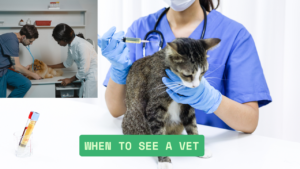The health of cats depends upon obtaining sufficient water supply. Dehydration can cause serious problems. The insufficient water consumption in many cats leads to a higher risk of dehydration for them. Your knowledge about dehydration symptoms together with helpful practices will safeguard your cat’s safety.
Why Cats Get Dehydrated

Why Cats Get Dehydrated, the natural water intake behavior is not present in cats. Wild cats absorb their required moisture from their natural diet. The amount of water consumption among dry-food-fed domestic cats usually remains below healthy levels. Hot weather together with sickness and problems with the kidneys will often create dehydration in cats.
Signs of Dehydration in Cats

1. Loss of Skin Elasticity
You should pinch the skin which lies between your cat’s shoulder blades to check its elastic reaction. Normal hydration shows itself when the skin quickly returns to its original position after pinching between the shoulder blades. Dehydration in cats is possible when their skin returns to normal position at a slow pace.
2. Dry Gums
A hydrated cat displays pink and moist gum tissue over their mouth. The gums of dehydrated cats are often either dry and sticky or pale colored and very thin.
3. Sunken Eyes
Eye dullness along with sunken eyes indicates dehydration in cats. All healthy eyes possess a shiny and transparent appearance.
4. Lethargy
Dehydration makes a cat display signs of exhaustion during normal physical activity. Seasoned rest and reduced motion tend to be observed in dehydrated cats.
5. Loss of Appetite
The lack of interest in food is one effect of dehydration in cats. Withdrawal from eating should trigger your attention because it indicates potential health problems.
6. Panting
Cats do not pant often. Panting in your cat becomes a concern as it suggests dehydration particularly when hot weather exists.
7. Decreased Urination
A hydrated cat urinates regularly. The production of less urine combined with avoidance of the litter box points to dehydration in your cat.
How to Rehydrate Your Cat

1. Provide Fresh Water
Your cat requires unrestricted access to clean water at every moment. Regular replacement of water sources helps stimulate your cat to drink.
2. Use a Water Fountain
Many cats prefer running water. A pet fountain serves as an attractive device for drink consumption.
3. Add Water to Food
Dilute water during mealtimes by adding it to your feline companion’s consumable food products. This increases their fluid intake.
4. Offer Wet Food
Cat food in wet form contains higher moisture content than dry kibble products do. Your cat’s dietary inclusion of these foods will help avoid dehydration problems.
5. Try Ice Cubes
Cat individuals show preference for licking frozen cubes. Placing ice cubes in their drinking water helps maintain a refreshing temperature.
6. Use Broth or Tuna Water
Your cat should receive low-sodium chicken broth and tuna water as fluids. Most feline pets cannot resist trying these particular taste combinations.
7. Keep Water Bowls Accessible
Position more than one water container in different areas of the home. Your cat will experience easier access to hydration because of this setup.
When to See a Vet

A seriously dehydrated cat requires professional medical treatment. Call your vet if you notice:
Persistent vomiting or diarrhea
Extreme lethargy
Refusal to drink water
Severe sunken eyes
A non-recovery of normal skin condition marks a concerning sign
The veterinarian will administer fluids by giving them through either subcutaneous injection or intravenous method. Fast rehydration of your cat becomes possible through this treatment.
How to Prevent Dehydration

1. Monitor Water Intake
Record daily water consumption of your cat. A decrease in water consumption without a reasonable cause signals dehydration.
2. Keep Their Environment Cool
Offer shaded and ventilated areas together with constant access to water during high temperature days. Periodically check their water container and maintain it with fresh water.
3. Feed a Balanced Diet
Wet commercial food should be added to your cat’s regular feeding routine. This helps maintain hydration.
4. Clean Water Bowls Daily
When water bowls become contaminated with filth. They will cause your cat to avoid drinking. Refrain from using dirty water containers since daily washing stops water from deteriorating.
5. Encourage Drinking
Try experimenting with water bowls from multiple types as well as water fountains along with flavored water to determine what attracts your cat to drink. Find out what object attracts your cat to engage.
The health situation becomes dangerous when dehydration affects cats. Being able to recognize the warning signals enables you to initiate prompt treatment. Your cat requires fresh water for drinking and moist food during the hydration status investigation. Your first step when your cat exhibits major dehydration symptoms should be to contact your veterinarian immediately. The combination of hydration creates a happy and healthy situation for your feline friend.
How can I tell if my cat is dehydrated?
Check for dry gums, sunken eyes, lethargy, and decreased urination. The skin pinch test also helps.
What should I do if my cat is dehydrated?
Provide fresh water, offer wet food, and use a pet water fountain. If symptoms persist, see a vet.
Can cats drink electrolyte solutions?
Yes, but only vet-approved electrolyte solutions. Avoid human sports drinks, as they contain harmful ingredients.
Why doesn’t my cat drink enough water?
Cats have low thirst drives. They prefer running water and get moisture from food.
How much water should my cat drink daily?
Cats need about 3.5–4.5 ounces of water per 5 pounds of body weight each day.
Can dehydration be a sign of illness?
Yes, dehydration can indicate kidney disease, diabetes, or infections. If dehydration is frequent, consult a vet.
Does dry food cause dehydration?
Dry food contains less moisture than wet food, so it may contribute to dehydration if cats don’t drink enough water.
When should I take my cat to the vet for dehydration?
If your cat refuses to drink, has persistent vomiting or diarrhea, or shows extreme lethargy, seek veterinary care immediately.
